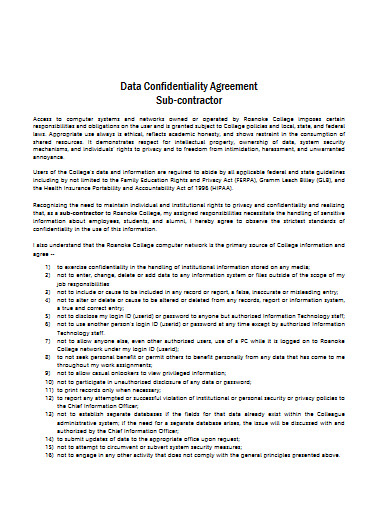












An organization holds not just one but tons of information in its data inventory. Because of this, many people would find it hard to distinguish which data is confidential and which is not. To help you classify the pieces of information better, here are the different types of details that are considered confidential.
– Name, birthdate, age, sex, and residential address
– Contact information
– Banking information
– Medical records
– Personal care matters
– Service records and file progress notes
– Personal goals
– Assessments and reports
– Guardianship orders
– Incoming and outgoing communication
Since the safety of company information is at stake, there’s a need for you to cover all necessary areas when preparing a data confidentiality agreement. But it doesn’t stop there. You also have to ensure that each of its sections is put in the right order. Doing so makes it easier for the readers to logically comprehend its context. Below, we’ve provided you with an outline to make sure you get everything covered in an orderly manner.
It is very crucial in technical writing to indicate the effectivity dates in business-related documents like request letters, notices, memos, agreements, and others. This lets the concerned audience know whether they have enough time to prepare themselves for any implementation or not. Therefore, you must begin your data confidentiality agreement by setting the completion date of when the implementation will take into effect.
Right after you’ve set the effectivity date, the next step that you have to take is to name who the involved parties are. As for a data confidentiality agreement, the parties are categorized as the disclosing party and receiving party. Naming the participants is an important factor to look into as per standard dispute resolution policy.
The purpose of an agreement has to be known not just by the participants but also by the other authorized audiences. Hence, it has to be stated in your document clearly. For example, the disclosing party has to provide its company’s market research plan to potential investors as an act of appealing for their interests.
Since the agreement is all confidential data, describe what it is thoroughly. The different types of sensitive information were enumerated above for your reference. Take note that plans, research findings, and evaluations are some of the other kinds of confidential information that can also be considered as a subject of an agreement.
Just like any agreement, data confidentiality also has exclusions. Here are some excellent examples:
1. The data is already owned by the receiving party even before the agreement.
2. The data was already knowledgeable about the disclosed information through another source.
3. The disclosed data is already known to the public.
Once the exclusions have been enumerated, define each item that the receiving party has to agree with. This might include the non-disclosure of information without the authorization of the disclosing party, non-disclosure of information with parties other than the participants, and the usage of the private details for business activities only.
Termination clause details the appropriate procedures whenever a breach in the agreement takes place. The most common resolution for this type of agreement is the injunction. It’s when the court orders the breaching participant to discontinue further disclosures of sensitive information.
According to the University of Delaware, any confidential data can be secured by observing the following:
– Encrypting them on the database
– Physically sealing devices and printed documents
– Proper disposal of data, devices, printed records
– Managing data acquisition
– Managing data usage
There are eight types of network attacks on data confidentiality, according to OmniSecu. They include the following:
– Port Scanning and Ping Sweeps
– Phishing and Pharming
An active attack is a network attack where the hackers alter the data’s details, which is typically done to damage their targets’ reputations.
Data in all forms can either make us or break us. To avoid the latter, we put most of them into confidentiality. However, there are some business undertakings that require them. Fortunately, we can still protect this sensitive information with the help of a data confidentiality agreement.